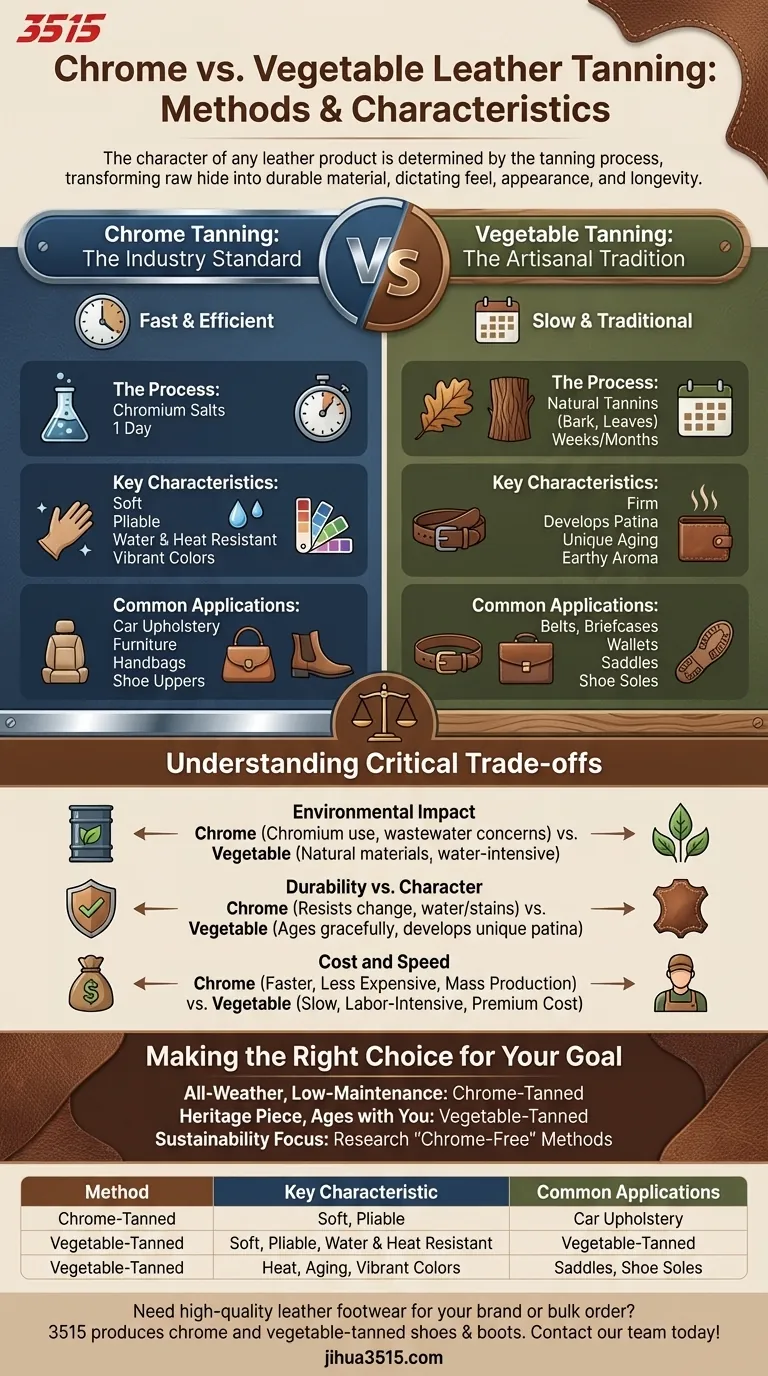The character of any leather product is determined long before it is cut and stitched. The fundamental tanning process transforms raw animal hide into durable, usable material, and the method chosen dictates its final feel, appearance, and longevity. The two dominant methods are chrome tanning, a fast, modern process creating soft and water-resistant leather, and vegetable tanning, a slow, traditional craft that produces firm leather known for its ability to age beautifully.
The choice between tanning methods is not about which is universally "better," but which is right for the intended purpose. Chrome tanning prioritizes speed and flexible durability, while vegetable tanning champions craftsmanship, unique aging, and structural integrity.

Chrome Tanning: The Industry Standard
Chrome tanning is the most common method used today, accounting for over 80% of the world's leather. Its popularity stems from its incredible speed and efficiency.
The Process
This method utilizes a solution of chromium salts to tan the hide. The entire process is remarkably fast, often taking as little as one day to complete, which makes it ideal for large-scale industrial production.
Key Characteristics
Chrome-tanned leather is known for being soft, supple, and pliable from the start. It holds color exceptionally well, resulting in uniform and vibrant finishes. It also has a high degree of water and heat resistance, making it very durable for everyday use.
Common Applications
Due to its flexible durability and consistent finish, you will find chrome-tanned leather in car upholstery, furniture, fashion handbags, gloves, and the uppers of most shoes and boots.
Vegetable Tanning: The Artisanal Tradition
Vegetable tanning is the oldest tanning method known to man, relying on natural, organic materials. It is a slow, methodical process prized by artisans and makers of high-end goods.
The Process
This method uses tannins, natural polyphenols found in organic matter like tree bark (oak, chestnut) and leaves. Hides are soaked in progressively concentrated vats of these tannins over a period of weeks or even months.
Key Characteristics
Vegetable-tanned leather is initially firmer and stiffer than its chrome-tanned counterpart. It has a distinctive sweet, earthy aroma and will develop a beautiful and unique patina over time, darkening and softening with use and exposure to sunlight.
Common Applications
Its structural integrity makes it perfect for durable goods that need to hold their shape. This includes high-quality belts, sturdy briefcases, wallets, saddles, and the soles and heels of fine footwear.
Understanding the Critical Trade-offs
Neither method is without its compromises. The right choice depends entirely on the desired outcome for the final product.
Environmental Impact
Chrome tanning’s primary drawback is its use of chromium, a heavy metal. While modern tanneries employ sophisticated wastewater treatment, the potential for environmental contamination exists if not managed responsibly.
Vegetable tanning is generally considered more environmentally friendly due to its use of natural, biodegradable materials. However, it is a far more water-intensive process.
Durability vs. Character
The concept of durability differs between them. Chrome-tanned leather's durability lies in its resistance to change; it resists water, stains, and stretching, maintaining its original look for a long time.
Vegetable-tanned leather's durability is in its longevity and ability to age gracefully. While more susceptible to scratches and water spotting initially, these marks become part of its unique character as it develops its patina.
Cost and Speed
The efficiency of chrome tanning makes it significantly faster and less expensive, enabling the mass production of affordable leather goods. The slow, labor-intensive nature of vegetable tanning makes the resulting leather a premium material with a much higher cost.
Making the Right Choice for Your Goal
Your preference for a leather product should be guided by its intended use and the characteristics you value most.
- If your primary focus is an all-weather, low-maintenance product: Look for chrome-tanned leather, valued for its consistent color and immediate softness.
- If your primary focus is a heritage piece that ages with you: Choose vegetable-tanned leather, which will develop a unique patina and character over its long life.
- If your primary focus is sustainability: Investigate newer, "chrome-free" mineral tanning methods, but always research the specific tannery's practices for a complete picture.
Understanding the tanning process empowers you to look beyond the surface and choose a product whose very foundation aligns with your values and intended use.
Summary Table:
| Method | Key Characteristic | Common Applications |
|---|---|---|
| Chrome Tanning | Soft, pliable, water-resistant, fast process | Shoe uppers, handbags, gloves, upholstery |
| Vegetable Tanning | Firm, develops patina, ages beautifully, slow process | Shoe soles, belts, wallets, saddles |
Need high-quality leather footwear for your brand or bulk order? As a large-scale manufacturer, 3515 produces a comprehensive range of chrome-tanned and vegetable-tanned shoes and boots for distributors, brand owners, and bulk clients. Our expertise ensures you get the right leather for durability, style, and cost-efficiency. Contact our team today to discuss your production needs!
Visual Guide

Related Products
- Durable Leather Moc Toe Work Boots for Wholesale & Custom Manufacturing
- Wholesale Leather Work Boots with Customizable Wedge Sole for Brands
- Wholesale Comfort Leather Business Shoes with Dial Lacing System
People Also Ask
- Which organizations develop safety standards for work boots? Ensure Compliance & Worker Safety
- What is a final tip for maintaining safety in a restaurant environment? Proactive Environmental Control
- Why are slip-on moc toe shoes a practical choice for formal events? Unlock Effortless Style & Comfort
- Why is it important to take care of your feet? Secure Your Mobility and Overall Health
- What materials are used for work boot outsoles? Choose the Right Material for Your Job


